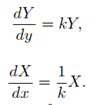SKEDSOFT
Method of Separation of Variables For PDE:
The method of separation of variables can be applied to linear partial differential equations, especially those with constant coefficients in the equation. To understand the strategy of this method, let us start by the following simple example:
Example: Consider the equations:

We assume that u(x, y) can be expressed as a product of a function of x and a function of y. This is an assumption and if we end up with a contradiction along the line then the assumption was wrong. If there is no contradiction then the assumption is valid. Thus, we seek a solution of the form:
u (x, y) = X (x) Y (y).
So that the equation becomes;

Dividing by ( Dx/dx)Y, instead of XY, we obtain

Since the left hand side is a functions of y alone and the right hand side is a functions of x alone, thw only possible solution if they are both equal to a constant say k. Thus we get two ordinary differential equations of the forms.

These are easily solved in terms of exponential functions to give

Thus the general solution to tha partial differentiation equations is

In this example we donot include either the boundary or initial conditions. However to solve PDE one need not only the diffrential equations but also boundary or initial conditions. Boundary condition can come in different forms:
1. Dirichlet Boundary Conditions:

2. Neumann Boundary Conditions:

3. Mixed Boundary Conditions:
